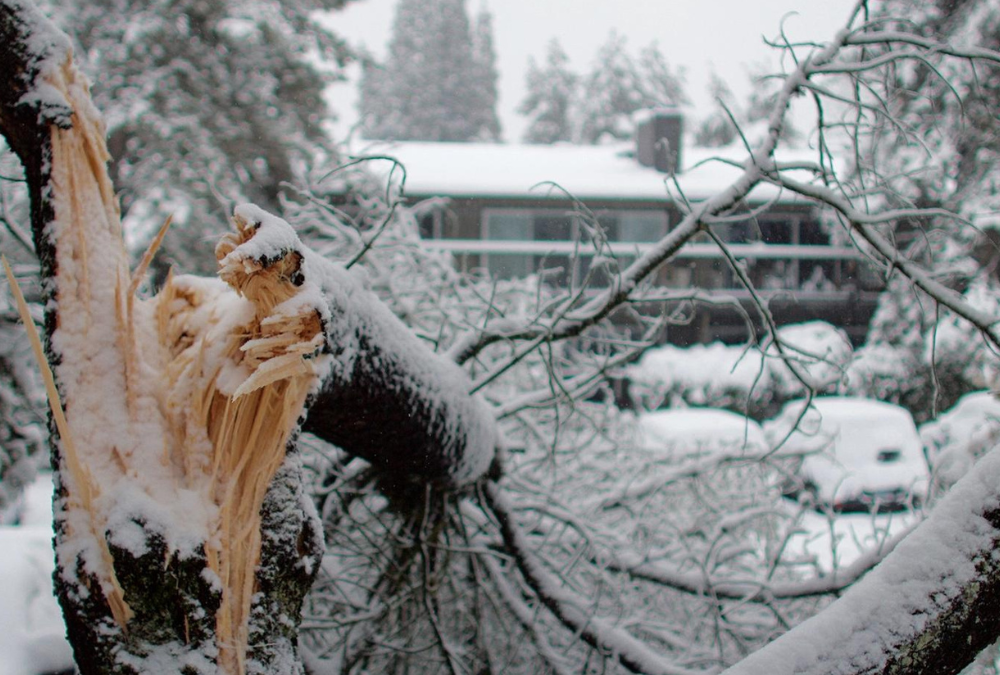Do you know what to do if a tree falls on your house or car during a winter storm? Unfortunately, many people don’t realize the danger that ice storms can pose to trees until it’s too late. Heavy accumulations of ice can cause branches and whole trees to break and fall, potentially causing damage to property or injuries. In this post, we’ll discuss some tips for avoiding damage from winter storms, and what to do if you’re unlucky enough to experience it. Stay safe out there!
What Makes Trees Susceptible to Ice Storm Damage?
Ice storms can be devastating to trees, causing breakage and damage that can leave them vulnerable to disease and insect infestation. While all trees are susceptible to some degree of damage from ice, certain factors can make them more vulnerable.
Trees are vulnerable to ice storm damage for several reasons.
- First, the weight of the ice can break branches or even topple the tree.
- Second, the ice can cause damage to the tree’s bark, which can lead to infection and rot.
- Third, the ice can prevent the tree from absorbing water and nutrients from the soil, causing it to weaken over time.
- Finally, the ice can damage the tree’s leaves, preventing them from photosynthesizing and making food for the tree.
As a result, trees that are subjected to frequent ice storms can become damaged or even die.
Minor Storm Damage
 Minor storm damage on trees is not always easy to spot. Sometimes, the damage is only visible when the leaves begin to fall off or when the tree starts to lean. Other times, the damage is immediately apparent, such as when branches are broken or torn away. However, regardless of how severe the damage appears, it is important to take action quickly in order to minimize the long-term effects. Minor storm damage can cause lasting damage to a tree if it is not addressed right away.
Minor storm damage on trees is not always easy to spot. Sometimes, the damage is only visible when the leaves begin to fall off or when the tree starts to lean. Other times, the damage is immediately apparent, such as when branches are broken or torn away. However, regardless of how severe the damage appears, it is important to take action quickly in order to minimize the long-term effects. Minor storm damage can cause lasting damage to a tree if it is not addressed right away.
In some cases, the damage may be minor enough that the tree will be able to recover on its own. However, if the damage is more severe, you may need to call in a professional tree service in order to save your tree. Regardless of the extent of the damage, it is important to take action quickly in order to give your tree the best chance of recovery.
Major Storm Damage
Major storm damage can occur on trees when heavy rains and high winds hit an area. This type of damage can uproot trees, break branches, and even topple large trees. Major storm damage can also result in the loss of leaves and needles, which can cause stress on the tree and make it more susceptible to disease.
In some cases, storm damage can be so severe that it results in the death of the tree. When major storm damage does occur, it is important to contact a tree professional for assessment and repairs.Tree professionals have the knowledge and experience to safely repair or remove damaged trees. They can also provide advice on how to prevent future storm damage. By taking proper precautions, you can help to ensure that your trees stay healthy and safe during severe weather.
Managing Tree Damage
Managing tree damage can be a difficult task. Depending on the extent of the damage, there are a few different options available. For small areas of damage, such as bark stripping or broken branches, pruning is often the best option. This involves carefully removing damaged or dead branches, which can help to promote healing and prevent further damage.
In cases of more severe damage, such as root loss or major trunk injury, it may be necessary to completely remove the tree. This should only be done as a last resort, as it can have a significant impact on the surrounding ecosystem. Managing tree damage can be a tricky business, but with careful planning and execution, it is possible to minimize the long-term impact of trees on the environment.
Assess Your Trees For Signs Of Damage
Assessing your trees for signs of damage is an important part of owning a home with trees. While trees can be resilient, they can also be susceptible to damage from heavy winds, ice, snow, and other severe weather conditions. Assessing your trees regularly will help you to identify any potential problems early on and take steps to prevent further damage.
Here are a few things to look for when assessing your trees:
- Missing or broken branches: This is one of the most obvious signs of damage and can be caused by high winds, heavy snow, or ice accumulation. If you see any missing or broken branches, it’s important to remove them as soon as possible to prevent further damage.
- Leaning trees: If a tree is leaning more than usual, this could be a sign that its roots are not anchoring it securely in the ground. Leaning trees are more likely to fall over in strong winds, so it’s important to monitor them closely and take action if necessary.
- Cracks in the trunk: Cracks in the trunk can weaken the tree and make it more susceptible to damage. These cracks can be caused by weather conditions or other factors such as insects or disease. If you see any cracks in your tree’s trunk, it’s important to have them examined by a professional as soon as possible.
By taking the time to assess your trees for signs of damage, you can help to ensure that they stay healthy and strong for years to come.
Checking for Snow Damage
Checking for snow damage on your trees is important if you want to keep them healthy. The first step is to look for cracks or splits in the trunk. These can be caused by the weight of the snow, or by the tree branch expanding and contracting in the cold weather. If you see any cracks, it’s important to call a tree expert right away.
They will be able to help you determine whether the tree can be saved or not. In some cases, the damage may be too severe and the tree will need to be removed. Checking for snow damage on your trees is an important part of being a responsible homeowner. By taking the time to inspect your trees after a heavy snowfall, you can prevent serious problems down the road.
Checking for Freeze Injuries
Checking for freeze injuries after a cold snap is an important part of winter tree care. Many types of damage can occur when trees are exposed to freezing temperatures, from dieback of the tips of branches to complete bark kill. While some degree of injury is inevitable, there are steps you can take to minimize the damage. Here are some tips for checking for freeze injuries on your trees:
- Inspect the tree for any physical damage, such as broken branches or cracks in the bark.
- Look for discoloration or wilting of the leaves, which may indicate that the cells have been damaged by the cold.
- Check the root system for signs of stress, such as poor growth or yellowing leaves.
- If you suspect that your tree has suffered freeze damage, contact a certified arborist or tree care specialist for further advice.
By taking these steps, you can help ensure that your trees survive the winter season unscathed.
How to Prevent Storm Damage to Your Trees
As a homeowner, you likely take great pride in your yard and the appearance of your home. Trees can add curb appeal, provide shade, and even increase your home’s value. However, trees can also be damaged by storms, leaving you with an unsightly mess and a hefty repair bill. Fortunately, there are several steps you can take to help prevent storm damage to your trees.
One of the most important things you can do is to choose the right tree for the location. Make sure to consider the tree’s mature size, as well as its preferred growing conditions. Additionally, make sure to plant the tree at the proper depth and distance from buildings and other structures. By taking these precautionary measures, you can help ensure that your tree is better able to withstand strong winds and heavy rains.
In addition to planting the right tree in the right location, you should also regularly prune your trees. This will help to remove dead or dying branches, as well as any branches that are growing in an unsafe manner. Storms can easily snap weak or diseased branches, so it’s important to remove them before they have a chance to cause damage. Finally, make sure to provide adequate support for your trees. Cabling and bracing can help to prevent accidents if a strong storm does strike.
By following these guidelines, you can help protect your trees from storm damage. With a little preparation, you can rest easy knowing that your trees are better able to withstand whatever Mother Nature throws their way.
Conclusion
Winter weather can be beautiful, but it’s also a time when homeowners need to be vigilant about the potential damage that ice and snow can do to their trees. Ice storms in particular can cause significant harm to trees, often leading to broken limbs or even downed trees. If you live in an area that is prone to winter weather events, it’s important to know how to identify tree damage and what steps you should take to mitigate the effects of ice and snow on your landscape. Let us know in the comments below about your experiences with winter weather and tree damage. Have you had to call a professional arborist for assistance?
References:
Preventing Winter and Ice Storm Damage to Trees
Winter Weather And The Damage It Can Cause To Trees
Plant Ice Resistant Trees

